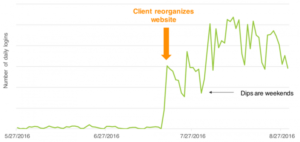This post was originally published on FirstFuel’s website. FirstFuel is now Uplight.
For many utilities, business customer engagement platforms have become essential building blocks for driving business customer satisfaction, improving revenues, and reducing service costs. However, taking an ‘if you build it, they will come” approach to building and updating your platform is a surefire way to send your investment dollars down the drain.
At FirstFuel, we’ve identified several key elements that contribute to the successful launch and adoption of your business customer engagement platform:
- Technology: Choosing a technology stack that’s scalable, secure, and flexible
- Customer Journey: Designing a business customer journey with a focus on long-term results.
- Platform Analytics Strategy: Using data and insights to identify opportunities to drive widespread adoption of your platform.
Technology
Many utilities are leveraging Software-as-a-Service (SaaS) applications to power their business customer engagement platforms because of their inherent flexibility and seamless, scalable integration with existing infrastructure. SaaS platforms are regularly updated based on customers’ feedback and usage platforms so, by choosing SaaS, you’ll ensure that your platform benefits from regularly added features and functionality and the best available technology.

Enabling Single Sign-On (SSO) is another key technology consideration. SSO provides a seamless integration between your new business customer engagement platform and your existing digital assets. Leveraging SSO makes it easy for customers and staff alike to find and log-in to your new platform.
While SSO may seem like a relatively small benefit among larger challenges, we have seen adoption rates improve substantially with the incorporation of SSO. The chart above shows the dramatic engagement improvements SSO technology drove on a client’s website. By enabling single sign-on technology, you’ll increase platform access and boost platform adoption among both business customers and internal staff.
Customer Journey
Many utilities think that their work is done once their business customer engagement platform is up and running. However, our experience has proven that concentrating on the end to end customer journey must be a key program focus to truly drive engagement.
Developing a solid understanding of the customer journey and the part your engagement platform plays in that journey should be a top priority. It is essential to give business customers a compelling reason to log on; marketing plans should start the conversation by enticing customers with a new way to pay their bill, or top tips for improving their energy use. Sending timely, personalized, actionable communications drive measurable increases in open and click through rates while regular communications around key events like billing or changes in energy use are a great way to drive repeat visitors to the platform.
It’s also important to consider the internal journey that your employees will follow to deliver exceptional customer service. Defining the best-practice journey for call center staff is a simple but effective way to improve customer satisfaction and driving awareness of your online customer tools during these important interactions is another way to boost engagement with your platform. Training and support for call center staff including call scripts, quick tips, supporting marketing collateral, template emails, and FAQs will equip your team with the tools they need to provide best in class customer service and drive overall customer engagement and satisfaction.
Platform Analytics Strategy
Finally, an important and often overlooked aspect of platform deployment is how the platform usage data will be used to assess platform performance and drive improvements.
To understand how customers use the platform and identify opportunities for improvement, it’s important to review usage data on a regular basis. Reviewing and acting on data such as return visits, click through rates, downloads, user pathways, abandon rates, and survey responses are key to planning strategies to reduce churn, increase customer satisfaction scores, and improve first call resolution rates. Using this data to find the bright spots or most frequently accessed parts of your website can also help improve the overall digital experience.
This data can also be used to develop a business customer segmentation strategy – we’ve seen clients segment their customers by business activity types, such as ‘retail, ‘office’, and ‘industrial’, or other behavioral characteristics such as ‘price chasers’ or ‘solution seekers’. Whatever approach you choose, a segmentation strategy will enable you to create a set of offers, messages, and channels that enable you to effectively engage customers, understand their unique needs, drive effective engagement strategies, and help customers improve their energy management.
Today’s business customer engagement solutions can provide you with the functionality you need to engage your customers and also the capability to analyze your data and turn it into actionable business customer insights. Focusing on creating seamless customer access, designing an effective customer journey, and continuously analyzing your platform’s performance will enable you to drive not only improved customer engagement, but also improved customer satisfaction, improved revenues, and reduced service costs.





